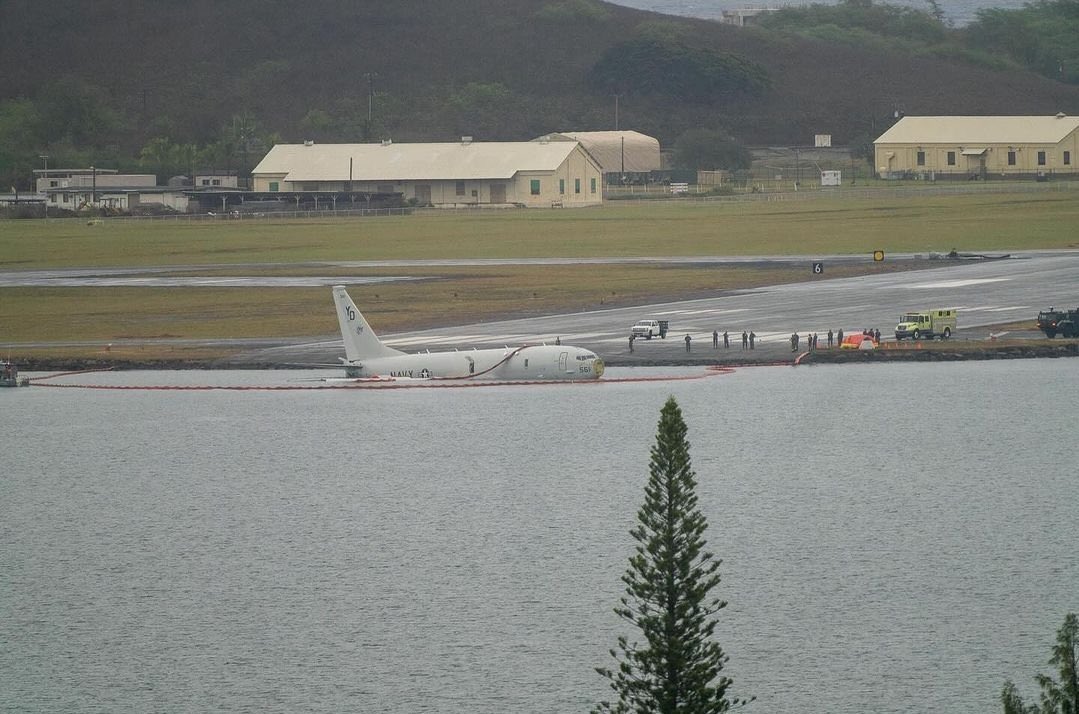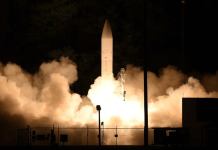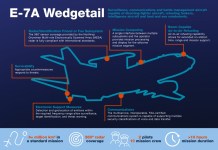The US Navy has decided to write off the P-8A Poseidon that overshot the runway in Hawaii and crashed into Kaneohe in 2023. Meanwhile, a US Navy F-35C carrier-variant stealth aircraft crashed in California on July 30.
A P-8A Poseidon that crashed in Hawaii’s Kaneohe Bay in 2023 is being retired by the US Navy, according to media reports. After first expressing optimism that the aircraft could be put back into service, the service concluded that the move would be extremely expensive.
This report comes days after reports emerged on social media, along with a video that featured a P-8 being dismantled. “P-8A maritime patrol aircraft 169561 YD-561 belonging to Patrol Squadron (VP) 4, ‘Skinny Dragons’, that overshot the runway at Marine Corps Air Station Kaneohe Bay in Hawaii in November 2023, is being scrapped,” read the caption of one such video posted by an aviation news account on X.
After a week of speculation regarding the fate of the aircraft, a spokesperson for the Naval Air Systems Command (NAVAIR) finally confirmed the development to The War Zone.
“The Navy’s P-8A Fleet Support Team, Boeing (P-8A Original Equipment Manufacturer), and AAR (P-8A Airframe Maintenance, Repair and Overhaul provider) conducted a comprehensive airworthiness, engineering, and repair assessment of the aircraft structure and systems,” it said. “As a result of the extensive repair requirements, necessity for unique aircraft manufacturing representative support equipment, and estimated cost required to return the aircraft to service in a mission capable configuration, pursuing a repair of the aircraft was determined to be cost-prohibitive,” it further added.
P-8A maritime patrol aircraft 169561 YD-561 belonging to Patrol Squadron (VP) 4 “Skinny Dragons” that overshot the runway at Marine Corps Air Station Kaneohe Bay in Hawaii on November 2023, is being scrapped.
The P-8A Poseidon was grounded due to irreparable damage from the… https://t.co/4ZiP4nlDaa pic.twitter.com/omhC6mqO7e
— FL360aero (@fl360aero) July 24, 2025
The dismantling of the aircraft is reportedly undergoing in Hawaii and is expected to be concluded by August 2025. All the identified serviceable aircraft components and mission systems were removed and will be used for other aircraft of the Navy’s P-8 fleet.
On November 20, 2023, the P-8A in question went off the runway at Marine Corps Air Station Kaneohe Bay, which is a component of Marine Corps Base Hawaii.
The incident occurred under rainy and cloudy conditions, with visibility reduced to one mile and a tailwind of 21 knots. The aircraft ended up in shallow water in Kaneohe Bay, about 50 yards offshore, resting on coral and sand. All nine crew members were able to return to shore after the accident without suffering any injuries.
The Navy removed nearly all 2,000 gallons of fuel from the aircraft to prevent environmental damage, and no fuel leaks were reported. The aircraft, assigned to the Patrol Squadron Four (VP-4) at the time, sustained severe damage, which worsened by the approximately two weeks it was submerged in saltwater.

A very difficult retrieval operation was conducted to bring the plane back to the ground. The aircraft was recovered on December 2, 2023, using inflatable salvage roller bags by a team from the Navy and the Marine Corps.
The Navy initially wanted to salvage the aircraft and estimated that it would cost $1.5 million. The service made efforts to return the aircraft to service until it realised that the cost was too high, and repairing the aircraft had become unsustainable.
The aircraft, valued at over $171 million, was deemed a total loss—the first for the P-8A program.
Based on the Boeing 737-800 airliner, P-8 is a versatile maritime patrol aircraft that excels in anti-submarine warfare, anti-surface warfare, intelligence, surveillance, and reconnaissance, as well as search and rescue missions. The P-8 can also be used for coastal patrolling.
P-8 has a maximum range of about 7,500 kilometres and an endurance of 10 hours, allowing the aircraft to conduct long-range patrols over regions such as the Indian Ocean or the South China Sea.
Moreover, it has been equipped with modern surveillance and reconnaissance equipment, such as a long-range X-band radar that can identify maritime objects hundreds of kilometers away. It also features sophisticated electronic warfare systems and high-resolution digital electro-optical (EO) and infrared (IR) sensors.
The aircraft is a very strategic platform that will be particularly helpful in the event of a conflict with China. The aircraft can detect submerged submarines by identifying magnetic disturbances. This is critical for tracking China’s growing submarine fleet. The aircraft can carry over 120 sonobuoys to detect and track enemy submarine activity, making it crucial for surveillance.

In terms of weaponry, the P-8A is equipped with air-to-surface missiles designed to precisely target maritime threats, as well as torpedoes for anti-submarine operations. With its High-Altitude Anti-Submarine Warfare Weapon Capability (HAAWC), the P-8A can engage submarines quickly and accurately without being exposed to low altitudes by deploying MK-54 torpedoes as glide bombs from as high as 30,000 feet.
The loss of P-8 does not bode well for the Navy, especially as tensions continue to rise over the Indo-Pacific. Although the Navy anticipates receiving future Poseidon deliveries through 2027, there is currently no sign that it intends to purchase an extra airframe to compensate for the loss.
That said, this is not the only loss to have happened to the US Navy in recent times. On July 30, the service lost one of its carrier-capable F-35C aircraft.
F-35C Goes Down
A US Navy F-35 stealth aircraft crashed in California on July 30 near Naval Air Station Lemoore, according to a Navy press statement. The pilot ejected safely, and the cause of the crash is under investigation, the statement said.
According to the Navy, the stealth fighter was assigned to Strike Fighter Squadron VF-125, also referred to as the “Rough Raiders.” The VF-125 is a Fleet Replacement Squadron, responsible for training pilots and aircrews.
There are still very few details available. However, we do know that the Naval Air Station Lemoore houses F-35C and F/A-18E/F tactical jets, and is the Navy’s main strike fighter base on the West Coast.
This is the second F-35 crash of 2025. In January this year, an F-35 belonging to the US Air Force (USAF) crashed in Alaska on January 28th. The pilot ejected to safety, but the aircraft was badly damaged. According to reports, the pilot experienced an “in-flight malfunction.”
However, this is only the second crash of an F-35C.
Earlier, in January 2022, a US Navy F-35C (tail number 169304) from Strike Fighter Squadron (VFA-147) suffered a ramp strike while landing on the USS Carl Vinson in the South China Sea and was lost overboard. The pilot was performing routine flight operations when the incident took place. After his safe ejection, the pilot was recovered by a military helicopter, according to the Navy.
The F-35C Lightning II, developed by Lockheed Martin, is the US Navy’s carrier-based variant of the F-35 Joint Strike Fighter family. It features larger wings and reinforced landing gear compared to its Air Force (F-35A) and Marine Corps (F-35B) counterparts, enabling catapult launches and arrested landings on aircraft carriers.
The F-35C achieved initial operational capability with the Navy in 2019 and has since been deployed on carriers like the USS Carl Vinson. The aircraft recently made its debut during the US bombing campaign against the Yemen-based Houthis this year.
While the F-35C has rarely been in accidents, the other two variants—the F-35A and F-35B— have a long list of crashes to their name. The crash incidents are worrying because the F-35 Joint Strike Fighter (JSF) is the most expensive fighter jet in the world
- Contact the author at sakshi.tiwari9555 (at) gmail.com
- Follow EurAsian Times on Google News




